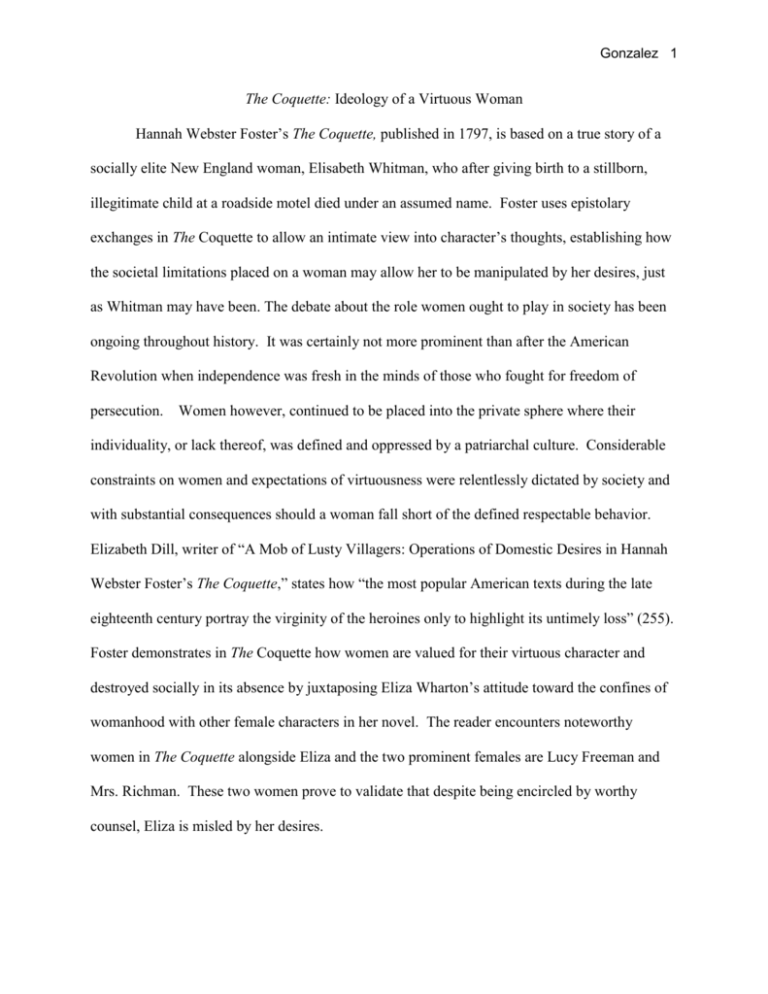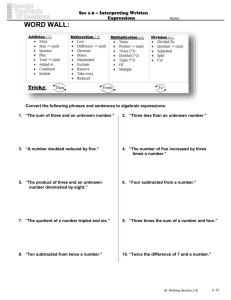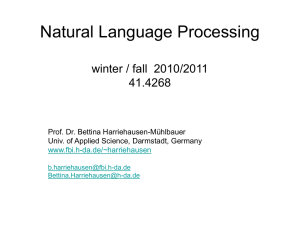Gonzalez The Coquette: Ideology of a Virtuous Woman Hannah
advertisement

Gonzalez 1 The Coquette: Ideology of a Virtuous Woman Hannah Webster Foster’s The Coquette, published in 1797, is based on a true story of a socially elite New England woman, Elisabeth Whitman, who after giving birth to a stillborn, illegitimate child at a roadside motel died under an assumed name. Foster uses epistolary exchanges in The Coquette to allow an intimate view into character’s thoughts, establishing how the societal limitations placed on a woman may allow her to be manipulated by her desires, just as Whitman may have been. The debate about the role women ought to play in society has been ongoing throughout history. It was certainly not more prominent than after the American Revolution when independence was fresh in the minds of those who fought for freedom of persecution. Women however, continued to be placed into the private sphere where their individuality, or lack thereof, was defined and oppressed by a patriarchal culture. Considerable constraints on women and expectations of virtuousness were relentlessly dictated by society and with substantial consequences should a woman fall short of the defined respectable behavior. Elizabeth Dill, writer of “A Mob of Lusty Villagers: Operations of Domestic Desires in Hannah Webster Foster’s The Coquette,” states how “the most popular American texts during the late eighteenth century portray the virginity of the heroines only to highlight its untimely loss” (255). Foster demonstrates in The Coquette how women are valued for their virtuous character and destroyed socially in its absence by juxtaposing Eliza Wharton’s attitude toward the confines of womanhood with other female characters in her novel. The reader encounters noteworthy women in The Coquette alongside Eliza and the two prominent females are Lucy Freeman and Mrs. Richman. These two women prove to validate that despite being encircled by worthy counsel, Eliza is misled by her desires. Gonzalez 2 “By attempting to weigh all choices objectively rather than heeding the protective morality mouthed by her contemporaries, [Eliza] may be blinded to the dangers of the choices she entertains” (Hamilton 136). Eliza’s personality begins to evolve from the moment she is liberated from her duties as caretaker for her fiancé Reverend Haly due to death. A man she was fully prepared to fulfill the role of the devoted daughter and marry as her parents requested, although she “never felt the passion of love” (808). She embraces her sudden freedom which has awarded her self-awareness and reveals a thirst for social interaction. Although the first letters are to Lucy, it is Mrs. Richman’s voice we plainly hear first through these letters. It is in Letter III that Mr. Boyer is introduced and he is obviously smitten with Eliza as displayed through constant eye contact, as well as proven in Letter IV from Boyer to Mr. Selby. He writes, “I was introduced to Miss Eliza Wharton; a young lady whose elegant person, accomplished mind, and polished manners have been much celebrated” (810). Unbeknownst to Boyer, Eliza wants to enjoy her freedom that “youth and innocence afford” as she admits to Mrs. Richman. Eliza insists Boyer could not possibly be an object of affection so quickly after obtaining freedom from her previous engagement. Eliza refers to Mrs. Richman as being “rather prudish” right after she tells Eliza that “fashionable dissipation is dangerous” (812). Claire Pettengill, author of “Sisterhood in a Separate Sphere: Female Friendship in Hannah Webster Foster’s The Coquette and The Boarding School,” writes how Eliza is a member of a respectable circle of women which “requires the women to exercise both the positive and the negative ‘arms’ of sisterhood within the female circle itself” (192). Mrs. Richman simply wants to shield Eliza and keep her from chasing the delusional dream that she can do as she pleases by having many suitors. It is not only Mrs. Richman that extensively warns Eliza that Major Sanford, who is introduced in Letter VI via invitation to Eliza for a ball, “is deficient in one of the great essentials of the Gonzalez 3 character, and that is, virtue” (816). Her dear friend Lucy, her best friend, warns her as well. Foster uses these two women in Eliza’s life to demonstrate how a woman can make choices that are clearly endorsed by society. Pettengill also mentions that Eliza is not the only one of these female characters to make major transitions in the novel as Lucy will get married, and Mrs. Richman will face the birth and death of her first child, Harriet. “The Coquette deals with the possible breakdown of an established female circle as its members accept suitors, marry, and bear children, or – worst of all – fall prey to seduction” (193). Lucy is clearly, from the beginning, very forthright in her opinions of behavior and choices of Eliza. It is Lucy who originally suggests to Eliza that her behavior is “coquettish” (809). With the overall majority of her correspondence addressed to, and from Lucy, it appears that Lucy is the mirror character that always makes the more appropriate choices. It becomes known to the reader that Lucy, as well as Mrs. Richman are making the necessary transitions from daughter to wife to mother. Lucy is engaged and eventually marries in the novel, becoming Mrs. Lucy Sumner; and Mrs. Richman has established a marriage and becomes pregnant with her first child. Lucy, seemingly Eliza’s conscience, offers the shrewdest guidance with her regard of Mr. Sanford in Letter XXXI: “I consider my time too valuable to be spent in cultivating acquaintance with a person from whom neither pleasure nor improvement are to be expected.” Lucy continues: I look upon the vicious habits and abandoned character of Major Sanford, to have more pernicious effects on society, than the perpetrations of the robber and the assassin…But to the disgrace of humanity and virtue, the assassin of honor, the wretch, who breaks the peace of families, who robs virgin innocence of its charms, who triumphs over the ill-placed confidence of the inexperienced, Gonzalez 4 unsuspecting, and too credulous fair, is received, and caressed, not only by his own sex, to which he is a reproach, but even by ours, who have every conceivable reason to despise and avoid him (841). Never were better words written to Eliza, who in her next letter to Lucy does not bother to acknowledge the lengthy rant about Major Sanford and his character. In fact, she addresses her feelings regarding Mr. Boyer, who by this time she has semi-committed herself to. Eliza has done this because she is the first to acknowledge that Boyer is a sensible choice considering he is obviously approved by her friends. In Letter XXXIII to Lucy, Eliza writes how she does not like Mr. Boyer’s continual discussions on “care and confinement.” She explains to Lucy that she clarified to Boyer that she would really appreciate it if he would discontinue any notion they are anything more than an amicably joined coupled, and to allow her more time for to offer any pledges of matrimony (843). As Kristie Hamilton, author of “An Assault on the Will: Republican Virtue and the City in Hannah Webster Foster’s The Coquette” explains the “evidence for [Eliza’s] coquetry in the novel consists largely of her taste for social events, her gay demeanor, her good-humored enjoyment of making conquests and her desire to remain free of ‘hymenial chain’ for a time” (141). Eliza becomes disconcerted by Mr. Boyer’s presence by Letter XXXVI. She explains to Mrs. Richmond how she has spent a majority of her time with Boyer before and after Lucy’s wedding, only to feel the constant strain of his judgment of her concerning her desire to socialize. “We are to have a ball here, this evening. Mr. Boyer has been with us, and tried to monopolize my company; but in vain. I am too much engaged by the exhilarating scenes around, for attending to a subject which affords no variety” (845). Gonzalez 5 Eliza is completely honest with Mrs. Richmond, as she is offers her the many reasons why she is exasperated by Boyer. She includes the fact that Major Sanford was at the ball and how she “drew him for a partner” (846) to dance. She goes on to write “He is an excellent dancer, and well calculated for a companion in the hours of mirth and gaiety.” Eliza is very much aware Mrs. Richmond disapproves of Sanford, yet Eliza continues in her attempt to convince her of the many reasons why he is so charming. The reader discovers that Eliza becomes unable to make a choice between the two men; yet she finally gives in to Boyer considering his persistent proposals of marriage and the reigning encouragement of her friends.. There is no time for congratulations as Major Sanford is just as persistent in his quest to have Eliza to himself, even though his offer doesn’t include marriage. The reader soon learns that Boyer has found Eliza and Major Sanford sitting intimately in the garden, and leaves angrily without providing the weeping Eliza a chance for explanation. In Eliza’s letter to Lucy, she goes through great lengths to detail her side of the story; however, she doesn’t allude to the separation from Boyer until the end. What she does is set the stage for Lucy, justifying how she has allowed Sanford’s charms to lead her astray: Yet I must own to you, from whom I have never concealed an action or idea, that his situation in life charms my imagination; that the apparent fervor and sincerity of his passion affect my heart. Yet there is something extremely problematical in his conduct (855). Eliza, for a short time, sees that Sanford is trying to keep her from marrying Boyer, yet “he mysteriously conceals his own intentions and views” (855). Eliza gives Sanford an opportunity to openly profess his love or else she chooses Boyer. Sanford does not and realizes she has become suspicious of his motives. She writes, “I know the right, and I approve it too; I Gonzalez 6 know the wrong and yet the wrong pursue” (856). Despite this interaction, Eliza is not able to bring herself to let him go. Eliza, by refusing to make the choice, has indeed made one. It is from this point forward that Eliza goes through “increasing alienation from those whom she most loves as she follows the conventional downward spiral of the seduced woman” (Hamilton 198). The formula for the seduction novel is less than virtuous behavior leads to the heroine’s promiscuity, followed by pregnancy and ending with death in childbirth. Gillian Brown, author of “Consent, Coquetry, and Consequences,” explains: At the center of the seduction scenario is a woman who comes to a destined end. In the predictability of her sad story, the seductive heroine represents an ideal of consent as originary and effective. Her exercise of consent, her affirmative or denial can be seen to be consequential. In their generative capacity (all sexually active women in seduction stories seem to immediately conceive) women exemplify an inevitable sequential process of consent that consent theory can only fantasize (635). Foster’s novel is not just a tale of seduction, as Eliza was “dedicated to choosing her way and her partners…something of a republican heroine” (Brown 636). It is an epistolary hypothesis of how a woman within high society makes her choices based on her individuality and alleged love, may find herself disgraced and alone. It is Mrs. Richman, a confident and wise married friend, who first told Eliza how she “had wrong ideas of freedom and matrimony” (822). Lucy, her best friend, states that she herself has “pride enough to keep [her] above coquetry, or prudery; and discretion enough…to secure [her] from both” (823) in her letter to Eliza attempting to keep her on “the path of rectitude and virtue” (838). In the end, Eliza cannot be Gonzalez 7 saved by Lucy or Mrs. Richmond, as she recognizes she has stained the social ideology of a virtuous woman. Gonzalez 8 Works Cited Foster, Hannah Webster. The Coquette. The Norton Anthology of American Literature: Volume A. Ed. Nina Baym. W.W. New York. 2007. 806-904.Print. Brown, Gillian. "Consent, Coquetry, and Consequences." American Literary History 9.4 (1997): 625-652. MLA International Bibliography. EBSCO. Web. 24 Apr. 2011. Pettengill, Claire C. "Sisterhood in a Separate Sphere: Female Friendship in Hannah Webster Foster's The Coquette and The Boarding School." Early American Literature 27.3 (1992): 185-203. MLA International Bibliography. EBSCO. Web. 24 Apr. 2011. Dill, Elizabeth. "A Mob of Lusty Villagers: Operations of Domestic Desires in Hannah Webster Foster's The Coquette." Eighteenth-Century Fiction 15.2 (2003): 255-279. MLA International Bibliography. EBSCO. Web. 24 Apr. 2011. Hamilton, Kristie. "An Assault on the Will: Republican Virtue and the City in Hannah Webster Foster's The Coquette." Early American Literature 24.2 (1989): 135-151. MLA International Bibliography. EBSCO. Web. 24 Apr. 2011. Harris, Jennifer. "Writing Vice: Hannah Webster Foster and The Coquette." Canadian Review of American Studies/Revue Canadienne d'Etudes Américaines 39.4 (2009): 363-381. MLA International Bibliography. EBSCO. Web. 24 Apr. 2011.







